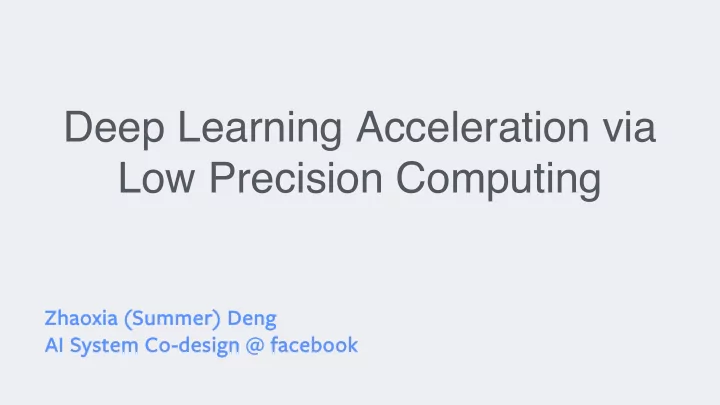

Deep Learning Acceleration via Low Precision Computing Zha Zhaoxia (S (Summer) r) Deng AI AI Sy Syst stem Co em Co-design design @ @ face facebook
Team Introduction • AI System Co-design team mission: • AI application-driven sw & hw co-design through • High performance numerical and architectural optimizations • HW performance modeling and simulations • Expertise • HPC and parallel algorithms • Computer architecture • Performance optimization and modeling • Numerical linear algebra, ML, and graph analytics
Agenda • Facebook AI workload characteristics • Low precision computing • Reduced precision floating point optimization • Fixed point quantization • AI system co-design for low precision computing • Model co-design • Hardware co-design
Agenda • Facebook AI workload characteristics • Low precision computing • Reduced precision floating point optimization • Fixed point quantization • AI system co-design for low precision computing • Model co-design • Hardware co-design
AI Growth and Its Drivers Big and better data Better algorithms More compute
AI Driven Services at Facebook Figure credit: Misha Smelyanski
AI Execution Flow Data Features Training Eval Inference Model Predictions
AI Inference in Facebook Datacenters
Workload characteristics Category Model Types Model Size (# Max. Live Op. Intensity Op. Intensity params) Activations (w.r.t. weights) (w.r.t. act & weights) FCs 1-10M > 10K 20-200 20-200 Recommendation Embeddings >10 Billion > 10K 1-2 1-2 avg. 380 Avg. 188 ResNeXt101-32x4-48 43-829M 2-29M Min. 100 Min. 28 Faster-RCNN (with Avg. 3.5K Avg. 145 Computer Vision 6M 13M ShuffleNet) Min. 2.5K Min. 4 Avg. 22K Avg. 172 ResNeXt3D-101 21M 58M Min. 2K Min. 6 Language seq2seq 100M-1B >100K 2-20 2-20 Deep Learning Inference in Facebook Data Centers: Characterization, Performance Optimizations and Hardware Implications https://arxiv.org/abs/1811.09886
Efficient AI inference challenges • Capacity crunch • Realtime model serving efficiency • Scale to billions of users Accuracy vs Capacity Increase of server capacity by Xiaodong Wang
Agenda • Facebook AI workload characteristics • Low precision computing • Reduced precision floating point optimization • Fixed point quantization • AI system co-design for low precision computing • Model co-design • Hardware co-design
Low-precision computing • Default precision: fp32 • Reduced-precision floating point Example of reduced precision representations • Fp16, bf16, fp8, etc. fp32 • Fixed point quantization fp16 • Int8, int4, etc. sign exponent (5 bits)fraction (10 bits) • Others bf16 • Posits (Gustafson 2016) • Logarithmic, k-means, etc.
Performance modeling Given FC (m, n, k), assume T = max(cpu_t, mem_t) • cpu_t = 2 * m * n * k / C • mem_t = S * (m * n + m * k + n * k) / B System performance is: • memory bandwidth bound when cpu_t <= mem_t; • Otherwise, compute bound. Compute bound scenarios: • CV Memory bound scenarios: • Language translation, recommendation Roofline: An Insightful Visual Performance Model for Floating- point Programs and Multicore Architecture. Williams et al.
Reduced precision optimizations • Fp16: Recommendation systems • Good programmability and negligible accuracy loss • Use cases: • Prepack the weights in NNs into fp16 • Convert dense and sparse features to fp16 for end-to-end performance optimizations Figure credit: Maxim Naumov
Int8 quantization • Dequantization: x = scale·(x q – offset) • Quantization: x q = clip(round(x/scale) + offset, -128, 127)
Challenges • Accuracy requirements • 0.02% for recommendation systems • 0.5% for computer vision models • Performance optimizations
Accuracy improving techniques (1) • Symmetric vs. Asymmetric • preserve sparsity, no nasty handling of offsets during matmul • slight loss of accuracy if using int8 for both weights and activations • Unsigned vs. Signed • Including 0 or not • Channel-wise quantization • Assign scale and offset for each channel
Accuracy improving techniques (2) • L2 error minimization vs. Min-max • Minimize the quantization errors for the more common values while allowing relatively large errors for outliers. • Requires the activation histogram profiling offline. • Outlier-aware quantization
FBGEMM • Facebook high performance FBGEMM performance for compute bound scenarios linear algebra library • Optimized on-CPU performance for low precision calculations • Supports accuracy-loss-minimizing techniques • Dynamically generates matrix- https://code.fb.com/ml-applications/fbgemm/ shape specific vectorized code
Int8 quantization for CV models • OCR text recognition using Rosetta • 2x speedups using int8 and int32 acc. • 2x speedups using int8 and int16 acc. • Outlier-aware quantization Rosetta: Large scale system for text • Model adjustments detection and recognition in images Fedor Borisyuk et al. • Int8 quantization workflow • Activation histogram profiling, graph transformation, kernel optimization, quantization space exploration
Agenda • Facebook AI workload characteristics • Low precision computing • Reduced precision floating point optimization • Fixed point quantization • AI system co-design for low precision computing • Model co-design • Hardware co-design
Model co-design • Int8 quantization on Rosetta • + 0.5% accuracy in both fp32 and int8 models • Int8 quantization on Relu recommendation systems • Wider FC layers to compensate for accuracy loss ShuffleNet https://arxiv.org/pdf/1707.01083.pdf
Hardware co-design • Low-precision computing can achieve 2x ~ 4x performance improvements on today’s hardware • How to meet the fast growing AI demand for tomorrow?
AI Inference Hardware Technology, energy and Dennard scaling Inference ASIC Hardware Nanometers Future of Computing, John Hennessey
AI Inference Hardware • Facebook designs its own hardware since 2010 • All designs released through open compute! • Facebook is partnering with HW vendors to build inference ASIC • Done via co-design with FB workloads in mind • Simulate performance with production models • Advise the quantization support from hardware
Thanks! • Q&A
Recommend
More recommend